
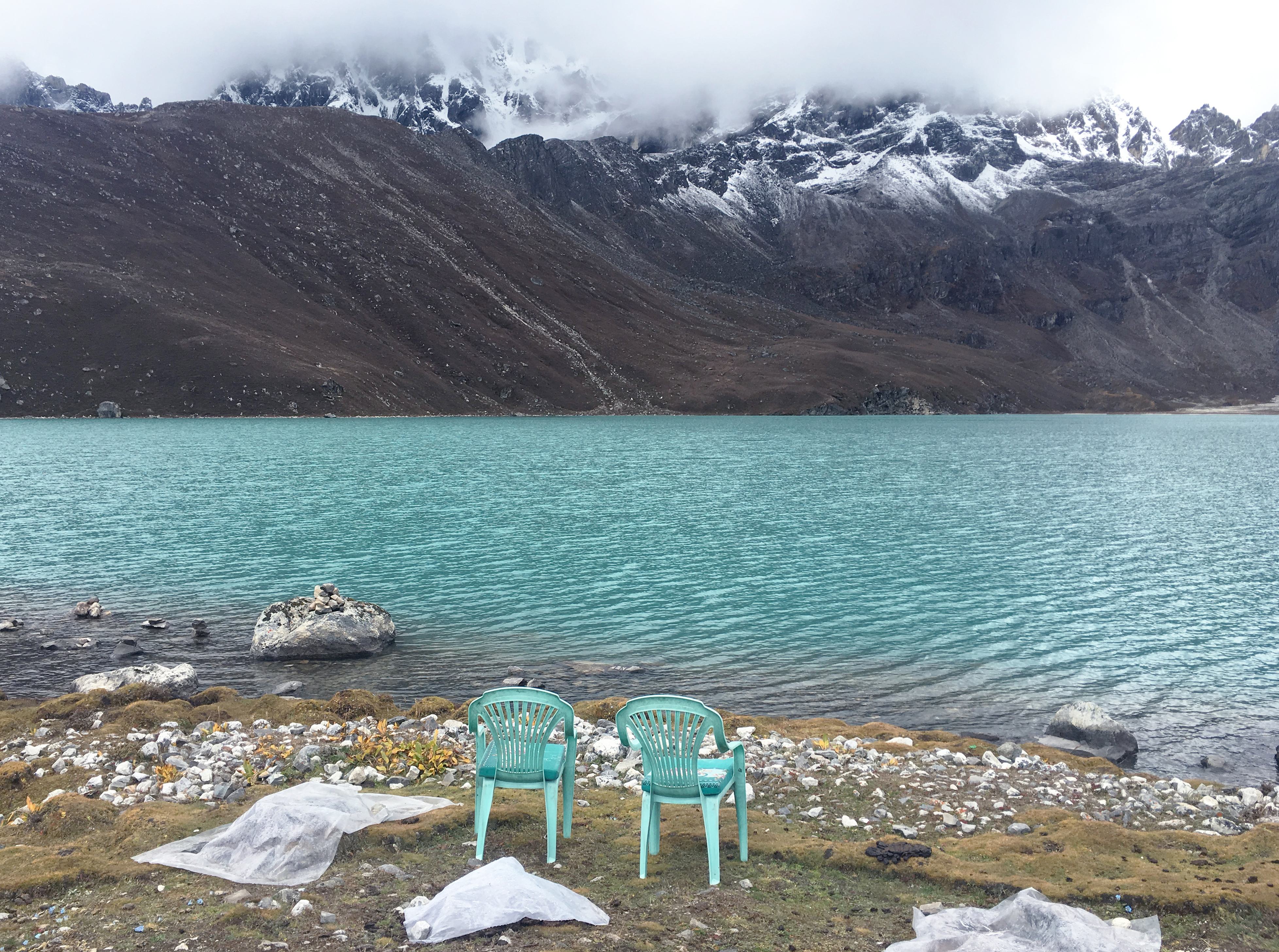
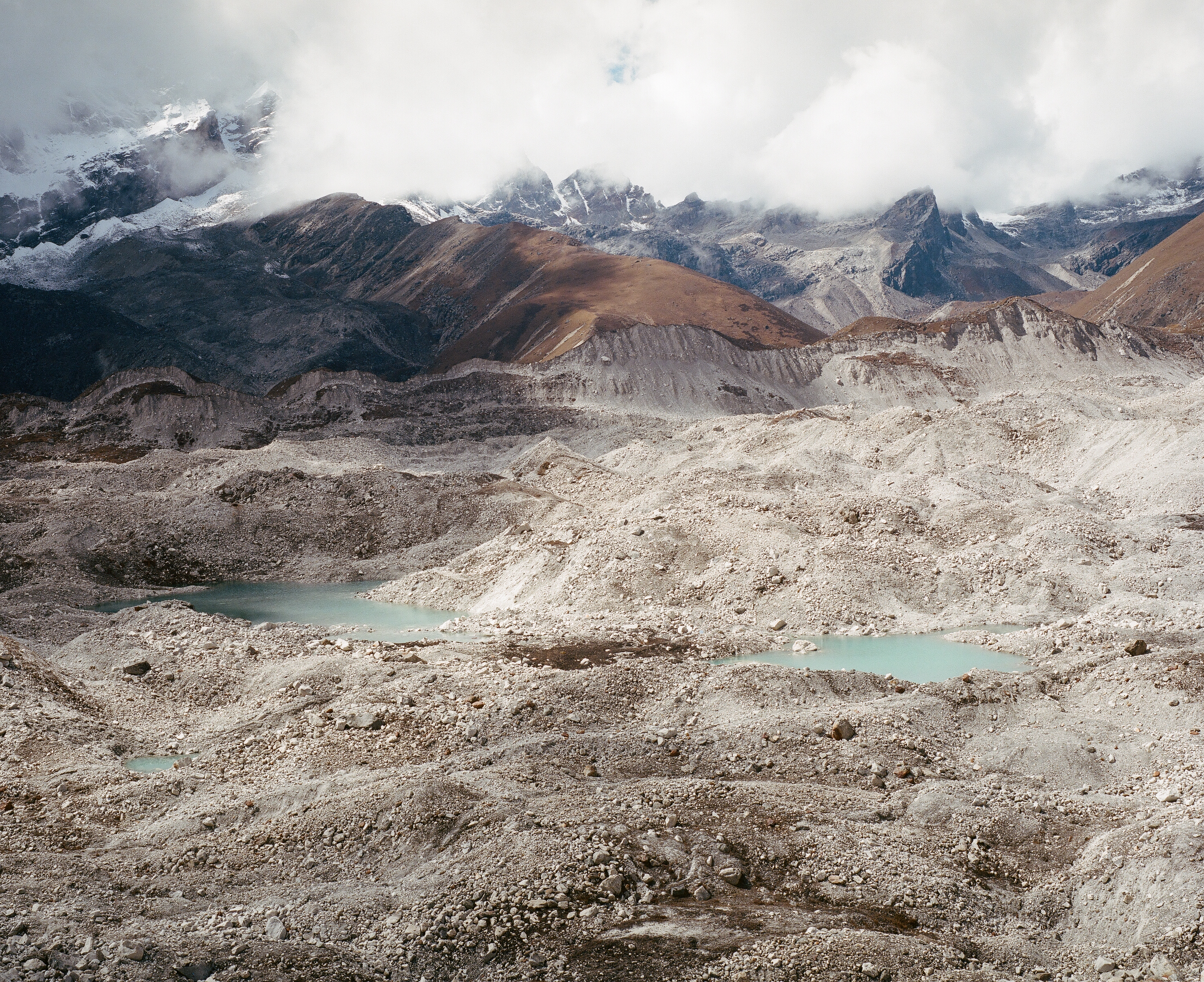
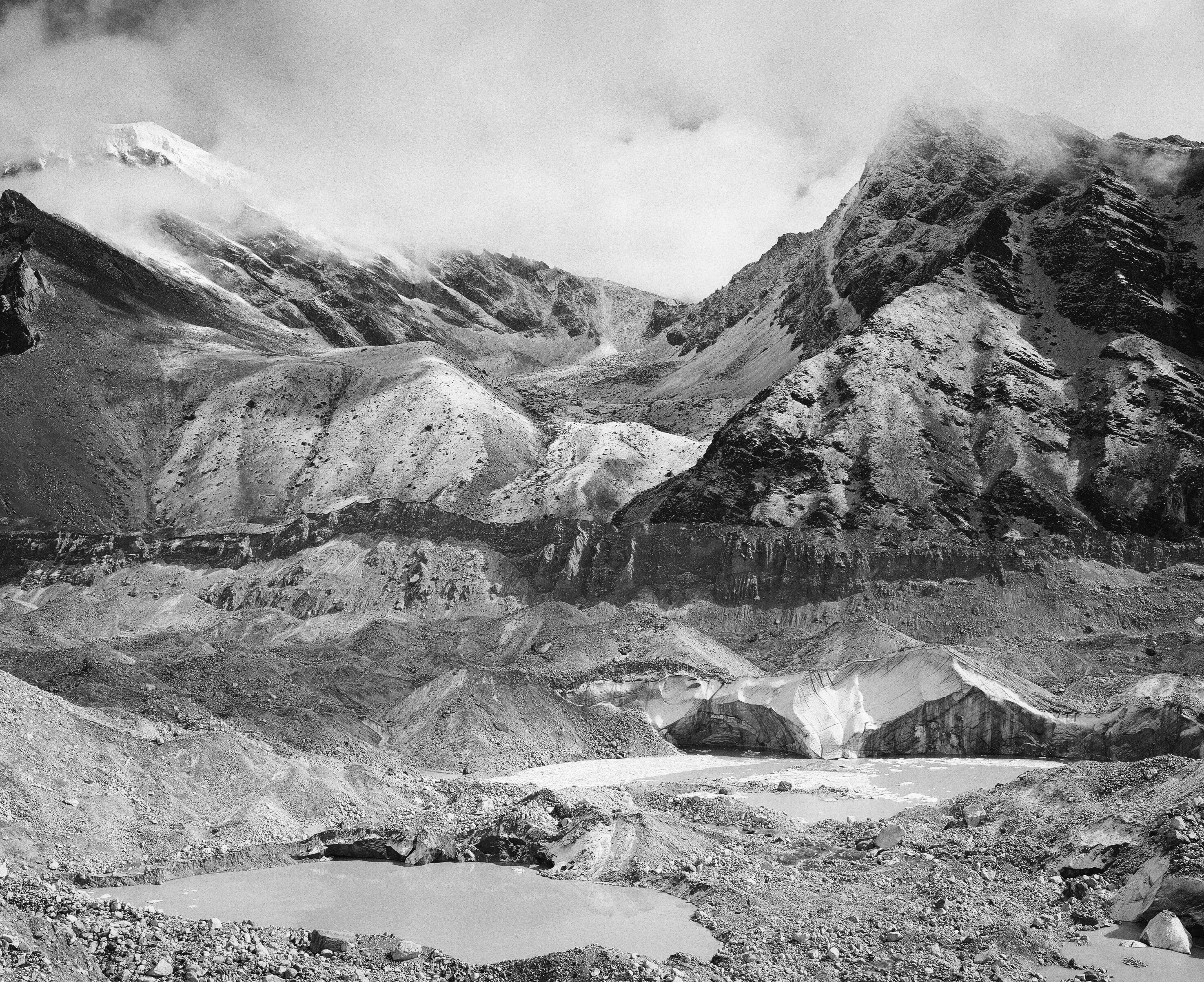

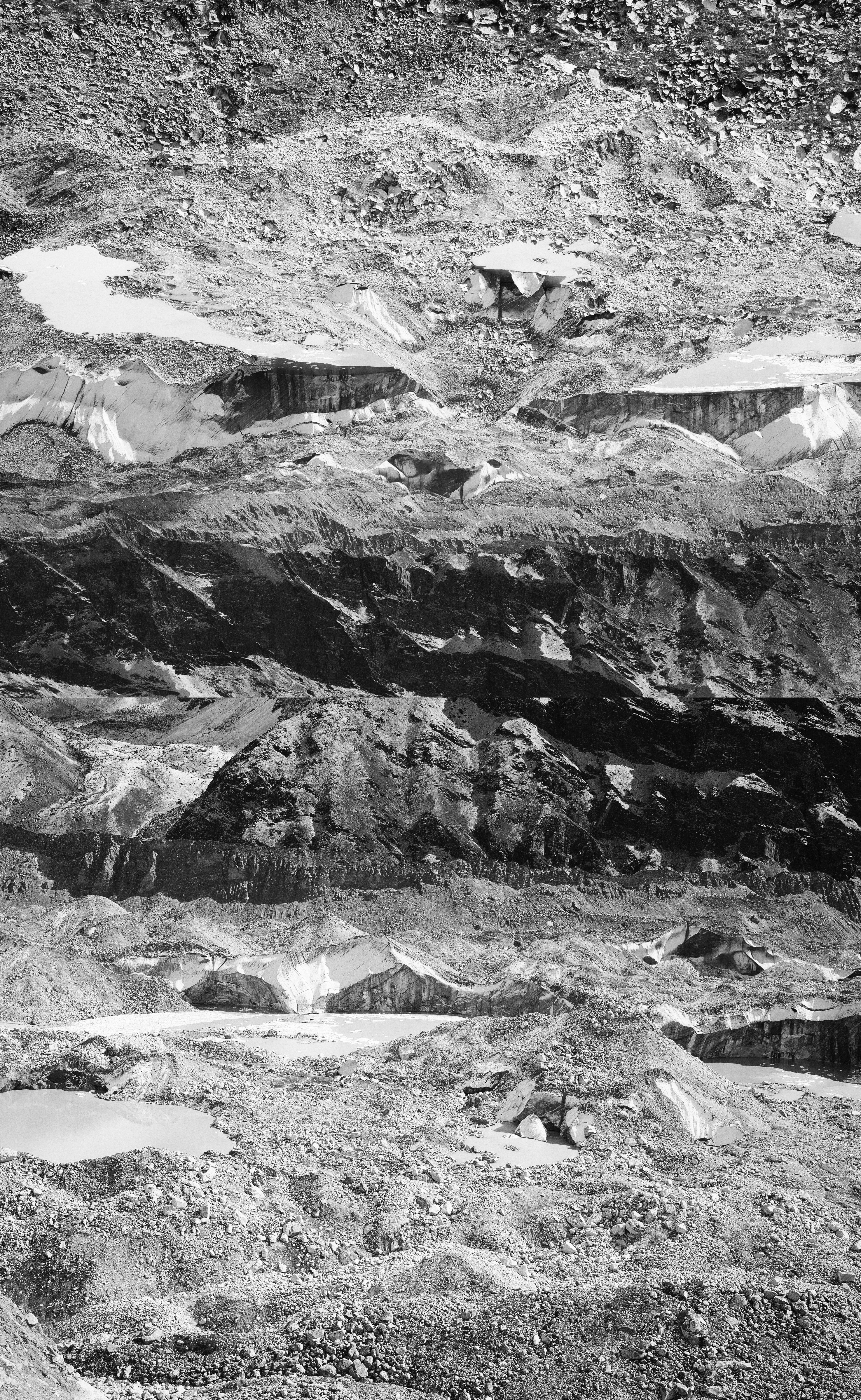
The satellites are spinning
A new day is dawning
The galaxies are waiting
For planet Earth’s awakening
SUN RA
AND THEN NOTHING TURNED ITSELF INSIDE OUT is a series of photographs of the Ngozumpa Glacier and Gokyo Lake in the Khumbu region of Nepal.
The work is a study of glaciers and an exploration of their decline in sacred mountain landscapes.
Set below the sixth highest mountain in the world Cho Oyu, the Ngozumpa Glacier is the longest glacier in the Himalayas. Glacial melt was once slow, the movement of the ice measured in many years, often centuries. In recent decades, the Nepali Himalayas are warming significantly and the Ngozumpa Glacier is showing signs of shrinking, thinning and the ice is rapidly melting; it’s as if time is literally flowing away.
In the Himalayas, it is believed by the local people that gods reside on mountaintops to distance themselves from the filth of human life. Sherpas have been known to link the decline of mountain glaciers to gods or deities. Human interference in the motherland of Nepal is unleashing the fury of the mountain gods.
The glacial melt of Ngozumpa (‘water source’) may be interpreted by the Sherpa people as a moral reprimand by the gods due to the departure from their traditional lifestyle to new lifestyles that generate physical and spiritual pollution.
The works hold space as majestic reminders that the earth is a living planet of complex beauty under threat. The fragility of the soaring landscape has been preserved as it was photographed and is now historical documentation in the timeline of climate change.
The photographs were exhibited with video, installation and an ambient soundscape made in collaboration with Erik Omen.
A new day is dawning
The galaxies are waiting
For planet Earth’s awakening
SUN RA
AND THEN NOTHING TURNED ITSELF INSIDE OUT is a series of photographs of the Ngozumpa Glacier and Gokyo Lake in the Khumbu region of Nepal.
The work is a study of glaciers and an exploration of their decline in sacred mountain landscapes.
Set below the sixth highest mountain in the world Cho Oyu, the Ngozumpa Glacier is the longest glacier in the Himalayas. Glacial melt was once slow, the movement of the ice measured in many years, often centuries. In recent decades, the Nepali Himalayas are warming significantly and the Ngozumpa Glacier is showing signs of shrinking, thinning and the ice is rapidly melting; it’s as if time is literally flowing away.
In the Himalayas, it is believed by the local people that gods reside on mountaintops to distance themselves from the filth of human life. Sherpas have been known to link the decline of mountain glaciers to gods or deities. Human interference in the motherland of Nepal is unleashing the fury of the mountain gods.
The glacial melt of Ngozumpa (‘water source’) may be interpreted by the Sherpa people as a moral reprimand by the gods due to the departure from their traditional lifestyle to new lifestyles that generate physical and spiritual pollution.
The works hold space as majestic reminders that the earth is a living planet of complex beauty under threat. The fragility of the soaring landscape has been preserved as it was photographed and is now historical documentation in the timeline of climate change.
The photographs were exhibited with video, installation and an ambient soundscape made in collaboration with Erik Omen.
AND THEN NOTHING TURNED ITSELF INSIDE OUT
Exhibited at COMMUNE, Waterloo
2-5 November 2017
Image Credits: And Then Nothing Turned Itself Inside Out, 2016; The End, 2016; Transcendence 3, 2016; She Sings in Silver Tones, 2016; Abode of the Gods 1, 2016; The Immeasurable Equation, 2016.
Exhibited at COMMUNE, Waterloo
2-5 November 2017
Image Credits: And Then Nothing Turned Itself Inside Out, 2016; The End, 2016; Transcendence 3, 2016; She Sings in Silver Tones, 2016; Abode of the Gods 1, 2016; The Immeasurable Equation, 2016.



THE KEEPER OF THE LAND series observes the landscape in the aftermath of areas affected by the Australian bushfires of 2019/20.
The work depicts the complexity and resilience of the Australian bush and its inhabitants; from destruction comes rebirth. The Rock Wallaby is the central figure, a survivor in the morning mist. The Rock Wallaby symbolises warrior energy and appears to teach us how to serve and not to serve the Australian land.
The triptych of a fire ravaged, blackened land, of scorched curled tree ferns, spiked Balga plants and of soaring eucalyptus trees was shot in the Blue Mountains of New South Wales.
Image Credit: The Keeper of the Land 1-3, 2020
The Keeper of the Land 1 was a finalist in the Ravenswood Australian Women’s Art Prize 2022 and awarded Highly Commended in the Emerging Artist category.
This series was exhibited for the HOME Bushfire Relief Art Auction Fundraiser at the National Art School in February 2020 and for Occupy the Fence in Manyana in July 2020.
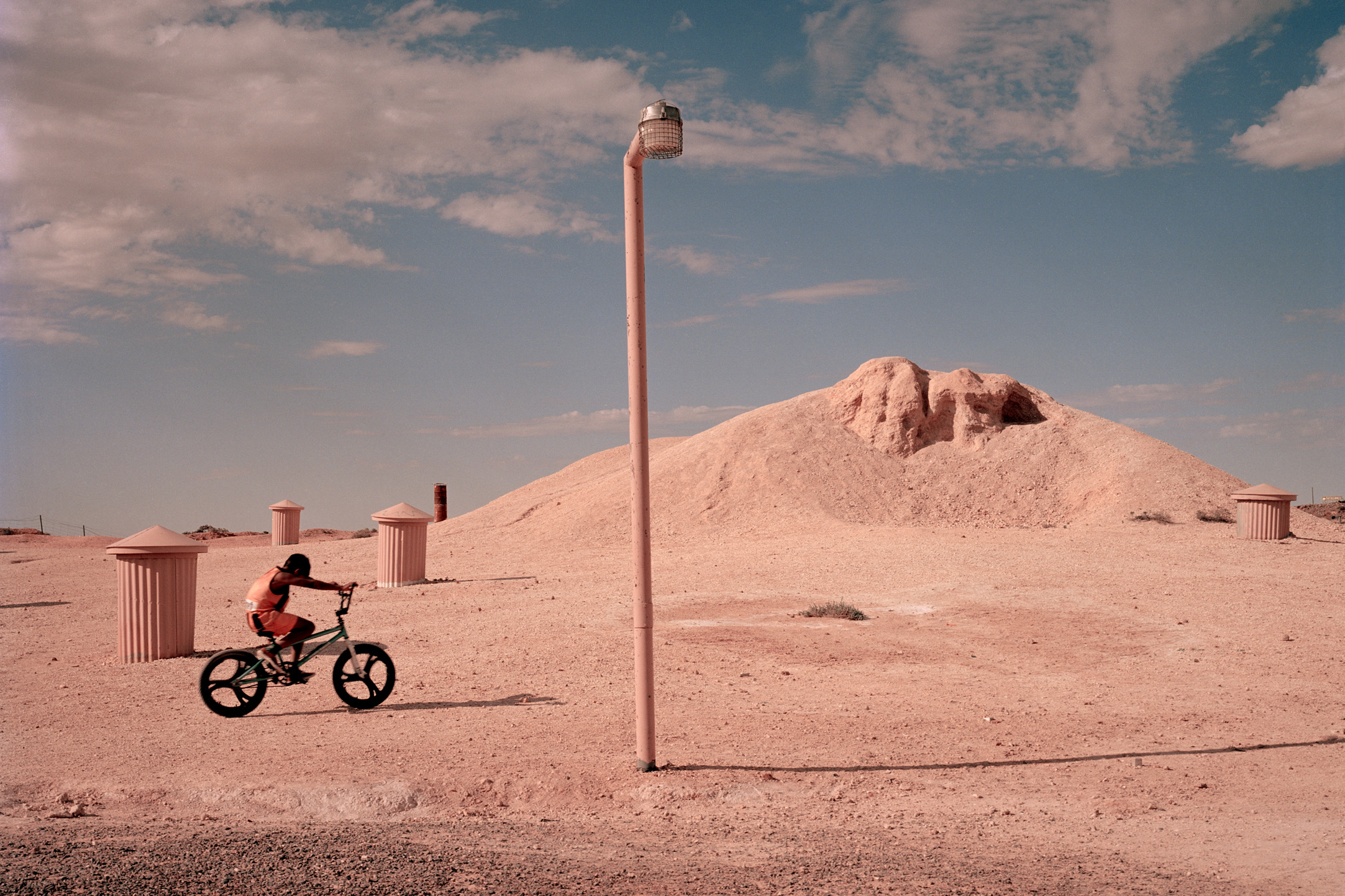
BOY ON BIKE was shot in Coober Pedy, a town in northern South Australia, 846 km (526 mi) north of Adelaide on the Stuart Highway. According to the 2011 census, its population was 1,695 (953 males, 742 females, including 275 indigenous Australians). The town is sometimes referred to as the "opal capital of the world" because of the quantity of precious opals that are mined there.
Coober Pedy is renowned for its below-ground residences, called "dugouts", which are built in this fashion due to the scorching daytime heat. The name "Coober Pedy" comes from the local Aboriginal term kupa-piti, which means "boys’ waterhole." Source: Wikipedia
Image Credit: Boy on Bike, 2015
The work was a finalist in the Australian Life photography prize for Art and About Sydney in 2016.





ANNAPURNA is a series of photographs from the Annapurna region, a massif of the Himalaya's in Nepal.
The work is a reflection on the contrasting elements seen in the extremes of nature. Majestic and spiritual, the sacred valleys and ranges are captured around an altitude of 4000m in the heartland of the Annapurna ranges and they depict a rapidly evolving landscape.
The scale and power of the land is of epic proportions, initially offering a breathtaking 'otherworldly' beauty to the explorer however this is coupled with an underlying darkness which in moments feels apocalyptic.
Image Credit: Annapurna, 2014 (selected works)
Annapurna was exhibited at Mild Manners Gallery in Surry Hills in December 2014.
© Rae Begley 2023
︎ Catalogue